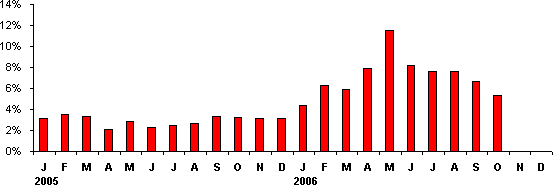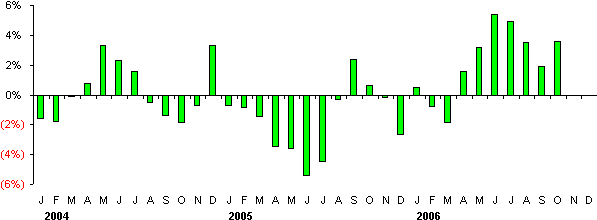IDEX Online Research: Jewelry CPI Surges in October
November 28, 06
Despite the lack of price pressure at the producer level, retail prices of jewelry in the U.S. market surged in October. Historically, producer prices and retail prices moved roughly in tandem, with retail price movement lagging producer price movement by a couple of months or so. However, this was not the case in October.
These statistics raise interesting questions. For example, are jewelers finally getting the message that they can’t keep cutting prices and still make a profit? Are retail jewelers trying to get out in front of the next producer price increase? And, of course, we wonder if the government statistics may contain some faulty data. Monthly revisions continue for a couple of quarters after the preliminary data is reported; however, the government would need to make significant revisions in the October data for it to remain on trend, and we believe that significant revisions are highly unlikely.
Jewelry Producer Price Index Continues to Decline
After surging in May, jewelry producer prices have shown a solid retreat. In October, jewelry producer prices rose by just over 5%. While that level of producer price inflation is half of the inflation rate in May, it is still well above the historic producer price index range of +2-3percent.
The graph below summarizes the Producer Price Index for jewelry and jewelry products in the U.S. market.
| U.S. Producer Price Index |
Jewelry producer prices fell roughly in line with all producer prices. Among all other producer categories, falling energy prices did not come as a surprise, but declines in overall producer prices were much greater than was expected. In addition to weakness in prices for finished goods, there has been a notable slowing in price growth of intermediate and crude production. This suggests that inflation pressures will subside further, since core intermediate product prices are often a leading indicator for consumer inflation.
Consumer Prices for Jewelry Jump
In a move that defies logic, retail jewelers raised prices sharply in October, as the graph below illustrates. According to the government statistics, the Consumer Price Index for Jewelry rose by 3.6 percent in October, well above September’s more modest gain of 1.9 percent.
| U.S. Consumer Price Index for Jewelry |
Jewelry retailers have been complaining of squeezed margins for the past two years. Diamond prices rose sharply in 2005, followed by much higher precious metals prices in 2006. All of this pressure appears to have driven merchants to raise prices in anticipation of the upcoming holiday selling season. That way, when they offer the inevitable discounts, they may be able to preserve some profit margin.
Except for jewelry prices, the inflation news was good: retail prices are barely inching upward, after soaring earlier this year. Clearly, the Fed’s anti-inflation prescription is working.
With core inflation under control, there is additional support for the Federal Open Market Committee to hold the fed funds rate steady at 5.25 percent near term. The ongoing contraction of the housing market will help rein in inflation, as will falling energy prices.
Overall, most economists are expecting inflation to recede for the rest of 2006 and into 2007 as overall economic growth slows. This bodes well for a soft landing and a moderate economic recovery beginning in late 2007.

